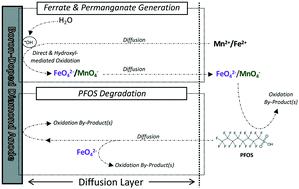当前位置:
X-MOL 学术
›
Environ. Sci.: Water Res. Technol.
›
论文详情
Our official English website, www.x-mol.net, welcomes your
feedback! (Note: you will need to create a separate account there.)
Degradation of perfluorooctane sulfonate via in situ electro-generated ferrate and permanganate oxidants in NOM-rich source waters
Environmental Science: Water Research & Technology ( IF 3.5 ) Pub Date : 2021-08-05 , DOI: 10.1039/d1ew00399b Sean T. McBeath 1 , Nigel J. D. Graham 1
Environmental Science: Water Research & Technology ( IF 3.5 ) Pub Date : 2021-08-05 , DOI: 10.1039/d1ew00399b Sean T. McBeath 1 , Nigel J. D. Graham 1
Affiliation

|
A novel process involving the in situ electrochemical generation of ferrate and permanganate oxidants, in circumneutral conditions, from low concentration aqueous iron (Fe2+) and manganese (Mn2+), is investigated for the treatment of the ubiquitous and highly recalcitrant micro-pollutant, perfluorooctane sulfonate (PFOS). The present study investigated the efficacy of both electro-oxidation (EO), and the simultaneous EO and ferrate/permanganate generation and oxidation, of PFOS as a potential drinking water treatment technology. While permanganate was shown to have little effect on PFOS removal, significantly increased degradation was observed when EO was coupled with ferrate generation and oxidation, significantly exceeding that of solely EO. From an initial concentration of 0.80 μM, final PFOS concentrations of 0.53 (±0.004), 0.43 (±0.01) and 0.27 (±0.01) μM were yielded during 10, 40 and 80 mA cm−2 electrolysis and an initial Fe2+ = 179 μM. In general, PFOS degradation rates increased with both increasing current density and initial Fe2+ concentration. Degradation was observed to follow mixed zero- and pseudo-first-order reaction kinetics for both the EO and simultaneous EO and ferrate oxidation. Finally, PFOS oxidation was not inhibited by the presence of low and high molecular weight organic scavenger species, and high concentrations of natural organic matter (NOM) improved PFOS removal due to hydrophobic interaction. Reduced ferrate species were also observed to increase NOM removal after electrolysis, by iron coagulant formation and subsequent flocculation.
中文翻译:

通过原位电生高铁酸盐和高锰酸盐氧化剂在富含 NOM 的源水中降解全氟辛烷磺酸
一种涉及在中性条件下从低浓度铁 (Fe 2+ ) 和锰 (Mn 2+ )水溶液原位电化学生成高铁酸盐和高锰酸盐氧化剂的新方法),研究用于处理普遍存在且高度顽固的微污染物全氟辛烷磺酸 (PFOS)。本研究调查了 PFOS 作为潜在饮用水处理技术的电氧化 (EO) 以及同时 EO 和高铁酸盐/高锰酸盐生成和氧化的功效。虽然高锰酸盐对全氟辛烷磺酸的去除几乎没有影响,但当 EO 与高铁酸盐的生成和氧化相结合时,观察到降解显着增加,显着超过单独使用 EO 时的降解。从 0.80 μM 的初始浓度开始,在 10、40 和 80 mA cm -2电解和初始 Fe 2+期间产生 0.53 (±0.004)、0.43 (±0.01) 和 0.27 (±0.01) μM 的最终 PFOS 浓度= 179 μM。一般来说,PFOS 降解率随着电流密度和初始 Fe 2+浓度的增加而增加。对于 EO 和同时的 EO 和高铁酸盐氧化,观察到降解遵循混合的零级和准一级反应动力学。最后,低分子量和高分子量有机清除剂物种的存在不会抑制 PFOS 氧化,并且由于疏水相互作用,高浓度的天然有机物 (NOM) 改善了 PFOS 的去除。还观察到减少的高铁酸盐种类增加了电解后 NOM 的去除,通过铁凝结剂的形成和随后的絮凝。
更新日期:2021-08-10
中文翻译:

通过原位电生高铁酸盐和高锰酸盐氧化剂在富含 NOM 的源水中降解全氟辛烷磺酸
一种涉及在中性条件下从低浓度铁 (Fe 2+ ) 和锰 (Mn 2+ )水溶液原位电化学生成高铁酸盐和高锰酸盐氧化剂的新方法),研究用于处理普遍存在且高度顽固的微污染物全氟辛烷磺酸 (PFOS)。本研究调查了 PFOS 作为潜在饮用水处理技术的电氧化 (EO) 以及同时 EO 和高铁酸盐/高锰酸盐生成和氧化的功效。虽然高锰酸盐对全氟辛烷磺酸的去除几乎没有影响,但当 EO 与高铁酸盐的生成和氧化相结合时,观察到降解显着增加,显着超过单独使用 EO 时的降解。从 0.80 μM 的初始浓度开始,在 10、40 和 80 mA cm -2电解和初始 Fe 2+期间产生 0.53 (±0.004)、0.43 (±0.01) 和 0.27 (±0.01) μM 的最终 PFOS 浓度= 179 μM。一般来说,PFOS 降解率随着电流密度和初始 Fe 2+浓度的增加而增加。对于 EO 和同时的 EO 和高铁酸盐氧化,观察到降解遵循混合的零级和准一级反应动力学。最后,低分子量和高分子量有机清除剂物种的存在不会抑制 PFOS 氧化,并且由于疏水相互作用,高浓度的天然有机物 (NOM) 改善了 PFOS 的去除。还观察到减少的高铁酸盐种类增加了电解后 NOM 的去除,通过铁凝结剂的形成和随后的絮凝。









































 京公网安备 11010802027423号
京公网安备 11010802027423号